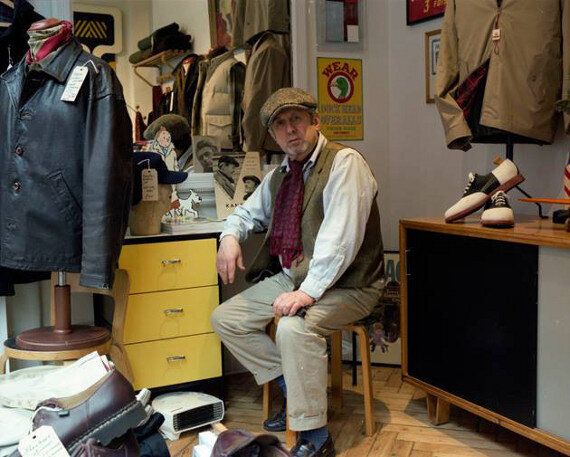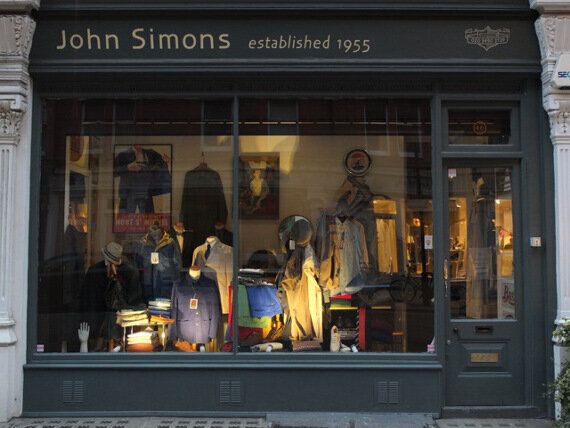We live today in an era of obsession with the fashion of celebrity, beset also by what Will Self recently called (in relation to the hipster) a "mindless attitudinising".
This much is true, because to take a look in the streets of old London town these days is to discover a modern man whose comportment has grown slipshod, more casual than ever before and many miles away from the ascetic form of the tailor's fitting room, a place to which men once headed in droves for help in expressing their urbanity.

And as stated by the creative director of Hunter, Alasdhair Willis, in a recent Sunday Times interview, clothes are a man's "billboard to the world", a truism that John Simons (above) has long known, he who has enjoyed a contemplative retail life that has seen him weather the follies and fads of the passing decades.
Take a turn into Chiltern Street, a quietly attractive thoroughfare in the heart of Marylebone, and discover this legendary keeper of a rare, sartorial flame at home in the cocoon of his shop. Ranking alongside 1960s style and fashion luminaries such as John Stephen and Doug Hayward, Hackney born and bred Simons is the last man standing of a tribe of modernists who helped cement the foundations of London's menswear industry. Which is no mean feat.
"I was born in London Hospital," he says. "My dad was a ladies tailor and all the family were in the clothing business, so I'd become quite fussy when I got my first suit made for my bar mitzvah."
Like Alan Sugar, another entrepreneur who has stayed the distance, John Simons first turned a profit when he had a stall just off Petticoat Lane near Spitalfields Market. "When I was 15 and still at school, I had some business cards made up with 'Far Out Tailors' printed on them," he laughs. "In those days, kids from that part of the world were quite streetwise when it came to business.
"My first premises, a place called Clothesville, was in 1963 next door to the Hackney Empire. After that we opened one in Walthamstow and then on Hill Rise in Richmond which was The Ivy Shop."
Coming out of World War 2, John was a sharp-dressing Jewish kid and one of the original modernists alongside Marc Bolan. "I knew Marc. He was a bit younger than me. By the mid-1950s there were modernists all over London. It was a jazz thing mostly and very big in the city. I was in the right place at the right time."
The American writer Gay Talese, who made his name in the 1950s and '60s, has shed some light on the nexus of clothes and art that best emphasises the modernist ethic: "My idea as a writer is to make the stitching last. I essentially write like a tailor; it's very methodical, very careful. I have a sense of design before I ever put a needle into my work."
Here he touches upon the contemplativeness that was the norm 50 years ago, a time when the music of choice for white avant-gardists (jazz) was linked with a desire for elegance in word, deed and tailoring. This was the order of the day, such facets of the complete personal taste of the post-war, flush-with-cash man forever imbued with a unique ethos.

"It's dressing without too much thought, but dressing stylishly and timelessly", says Paul, John's son, who helps him run today's business. John agrees. "It's always been a mid-Atlantic mix."
He says that the post-war period was "when the rich met the poor", with lords, ladies and East End kids coming together in the London mix to listen to the new music and enjoy something of a cultural exchange. Style influencers at the time, he says, were the Italian waiters of Soho. "They were always out in the street and well dressed. That was a big influence on London guys."
Simons is also the man who named the iconic Harrington jacket. Originally known as the G9 jacket as sold by the Baracuta brand, John sold it in his shop as the 'Harrington' after Rodney Harrington, the character played by Ryan O'Neal in the TV soap opera Peyton Place.
In the film world of the 1950s and '60s, the Harrington was a wardrobe staple of men like Frank Sinatra, Steve McQueen and Elvis Presley, with Eric Clapton and Paul Weller subsequently donning one for photoshoots that have lodged themselves in our collective memory.
The legendary Covent Garden shop John opened in the 1980s continued the tradition and started a buzz that was big enough for designer Paul Smith to cotton on to, the establishment of his Floral Street flagship coming soon afterwards.
Astutely, John has also developed his own label, and with a documentary in the works with Paul Weller, Kevin Rowland and Dylan Jones of GQ singing Mr Simons' praise as one of the essential go-to gentleman's outfitters, it would appear that in keeping faith with his original idea, John Simons has kept his soul when all around him others have been lost.
Things have changed and we are all executives of our own wardrobes, and as executives we don armour and go into white collar battle across town. Call it modernity. But what of men dressing in a more considered, classical manner as a semaphore that unequivocally expresses our individual rather than social status? There is, one hopes, still time and scope to rewrite the sartorial wrongs of the present day. It is, and has always been, a question of pride.
Click here for more information.
Photographs courtesy of Paul Simons
